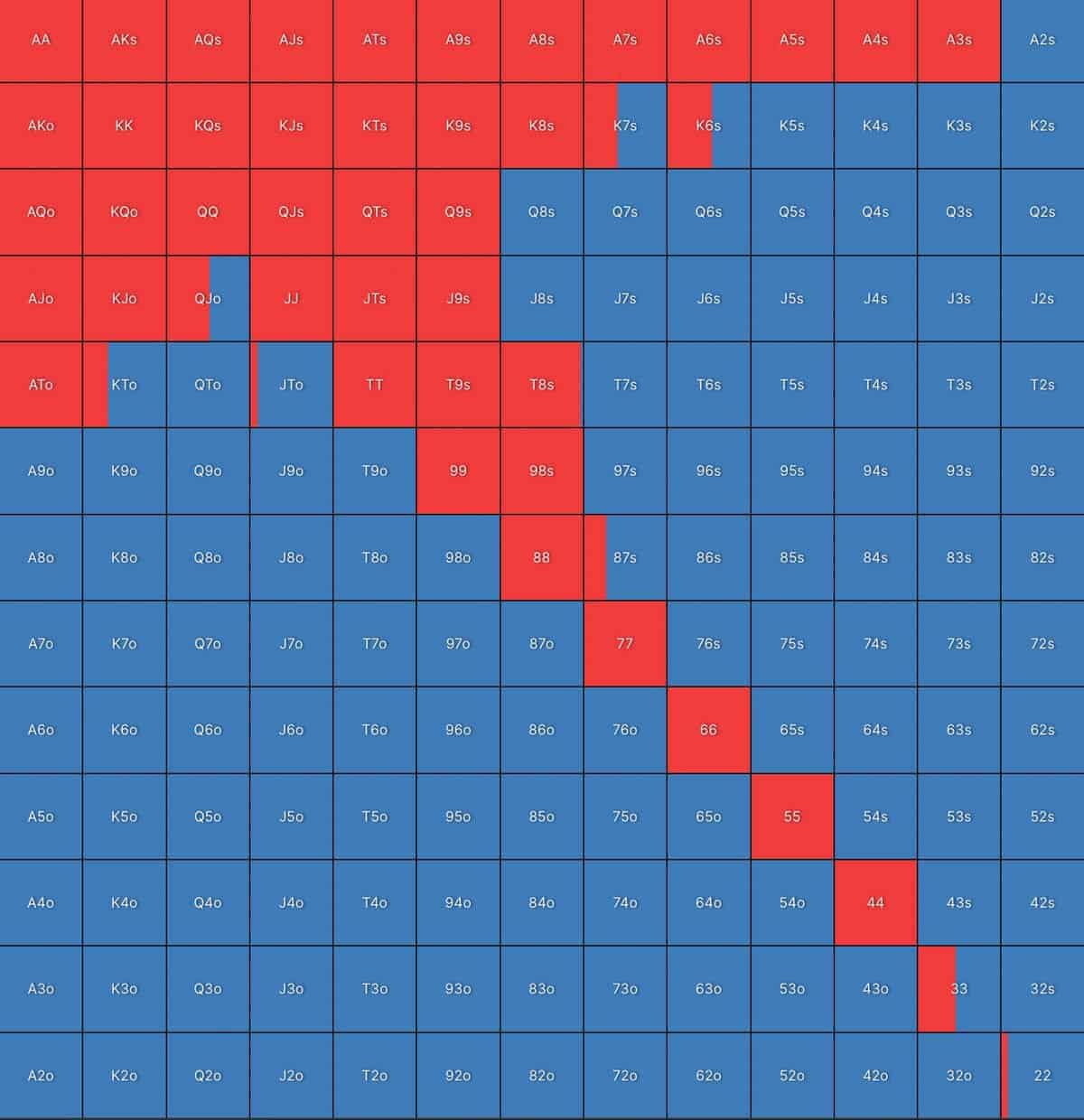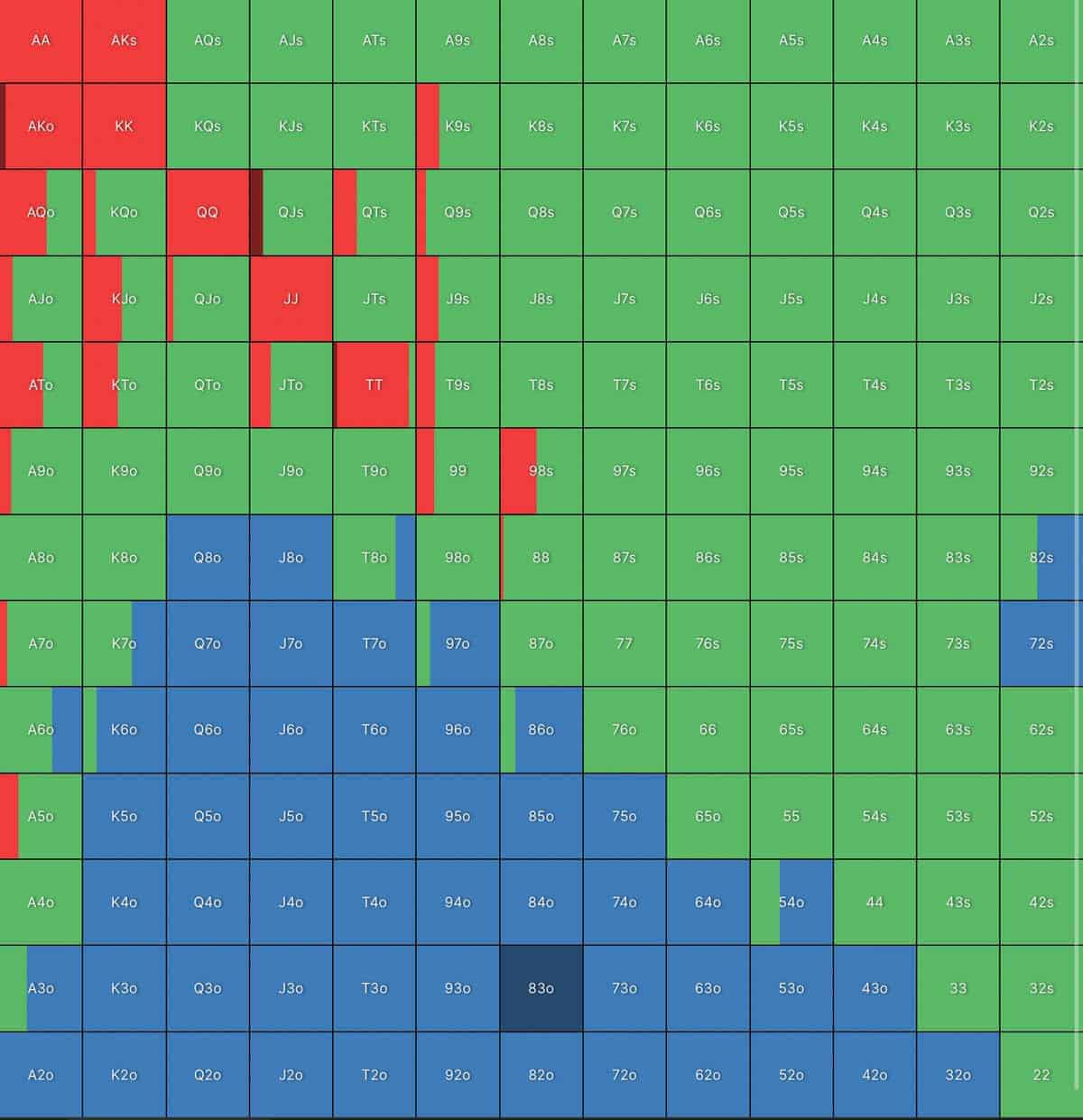Defending Against Continuation Bets
Dara O'Kearney
Apologies for my lengthy absence but I was away at the WSOP, in Cyprus and Barcelona. But now that I’m back I’m ready to start cranking out the strategy again for IPT.
Having concluded my series on continuation betting, the logical progression is to look at how we should defend against continuation bets. Let’s start with the same example we started with in my continuation betting series.
The under the gun player opens to 2.3 BB’s playing 40 BB’s, it’s folded to us in the big blind with the same stack or more (it doesn’t matter which: either way the hand is 40 BB’s effective), and we defend.
This is the optimal opening range for under the gun off 40 BB’s:

Our defending range in big blind should look like this:

As you probably remember from the continuation betting series, in all these grid diagrams, red means raise, green means call, blue means fold. If the square for a hand mixes more than one colour, it means that more than one action is optimal for that hand. Strictly speaking, to be playing perfectly optimally we should be doing each action more than once when a hand is a mix like this. So for example, with aces you should always raise, with A2s always call, while with KJo you should sometimes raise sometimes call. And with A3o sometimes call sometimes fold.
You do call and the flop comes Ah 8s 2d. You check as you always should on this flop which is better for your opponent’s range than yours, and he continuation bets small, say 1.2 bbs. What should you do with each of these hands, and why?
(A) A8
(B) AQ
(C) A7
(D) 88
(E) KQs
Before reading on, think what you’d do with each of these hands in this situations and why.
Ok, let’s have a look at what each hand should do
(A) A8
With two pair (so this is also true of A2 and 82s) we want to go ahead and raise for two reasons. We very likely have the best hand right now, and our opponents has lots of worse one pair hands he can call with, which means we can raise for value. Second, if we do have the best hand right now, our opponent will often have outs to outdraw us, so it’s a better result for us when we raise if he does fold than if we just call and give him the chance to outdraw us. This second reason is referred to as “equity denial” as it denies our opponent his equity (his chance to outdraw us). As a (very) general rule, facing a continuation bet, you want to raise your strongest hands that are vulnerable to being outdrawn for both value and equity denial.
(B) AQ
Raise for the same reasons. This might surprise you, but AQ is also strong enough to raise for value. Don’t make the mistake of thinking you can only raise hands you’re pretty certain are the best hand right now. To qualify as a value raise, a hand only has to beat a little over half the hands that will call the raise, in the same way that you only need to win a little over half the bets you make on anything at evens to be a winning gambler. With Ace queen, we beat all our opponents one pair hands except AK, and many of these hands have more outs against AQ than they do against A8, so we benefit even more from equity denial. If we raise and get reraised (threebet) we can re-evaluate.
(C) A7
Just call. This hand isn’t strong enough to raise for value (it won’t be ahead of enough of the hands that will continue). We are ahead of enough of the hands that continuation bet though, so we shouldn’t fold just yet.
(D) 88
Mostly raise, sometimes call. This might surprise you, as the hand is clearly strong enough to raise for value. While this is true, remember there are two reasons for raising : for value, and for equity denial. 88 doesn’t deny as much equity to our opponent because many hands like A9 that have three outs against A8 on this flop are almost drawing dead against 88. So we can just call with 88. This has one additional benefit: we are disguising the strength of our hand and our opponent might keep bluffing (or value betting worse hands) on future streets. If we only ever called relatively weak hands like A7 on this board we would be very easy to take advantage (or “exploit”) on later streets: our opponent could value bet us with impunity when he beats all these hands, or try to bluff us with big bets when he can’t. We therefore need to sometimes call with very strong hands (what is referred to as “protecting your range”), and the very best hand we have usually makes a good candidate to do this with. On this board 88 is the absolute best hand we can have (we would have raised with aces preflop) so we should call with it sometimes to protect our other calls.
On the other hand, if we have bottom set, we should always raise, for two reasons. First, it’s more vulnerable than 88 (only pairs higher than 88 have outs against middle set, but any pair has outs against bottom set). Second, when we have 88 it’s slightly less likely that our opponent has a second best hand that can call a raise, because we are blocking hands with an 8 he might have, such as 88, A8s, 98s, 87s. With 88 we have two blockers to all these hands, but since our opponent isn’t opening hands like A2s, 32s or even 22, the same is not true when we have bottom set.
(E) KQs
This also might surprise you, but with KQs we should almost always call. If we have a backdoor flush draw, we should always call (we can fold KQ of hearts some of the time since it has no backdoor flush draw). A mistake a lot of players make is as soon as they see the ace on the flop and their opponent bets, they assume the worst (that they have the ace) and they fold their modest pocket pairs and all king highs. However, against a good player who can recognise that this flop is so good for them they can just bet always irrespective of their actual hand, you will still have the best hand often enough with a pocket pair or a very good king to call a small bet (if you don’t believe me, just look back at the opening chart to see how many hands the opener has that have missed). If our opponent is bluffing with a hand that missed, it’s not just the packet pairs that are ahead: KQs is also ahead if our opponent didn’t start with a pocket pair and has missed the flop (unless he also has KQ). As a very general rule, the nut no pair as it’s called (the best possible hand that isn’t a pair) makes a good check call.
Secondly, even if we don’t have the best hand right now, we have possibilities to get there on the turn or at least by the river. In some ways KQs with a backdoor flush draw actually makes a better call than a pocket pair like 66. This is because if we are behind, we often have better chances of outdrawing our opponent with KQs than a pocket pair. A pocket pair only has two outs against a better pair or two pair, and it’s drawing almost dead against a set (needing to hit runner runner quads). KQs on the other hand has six immediate outs against any pair worse than queens, and even against a set it has a much better chance (it can make a flush or a straight by the river). There are also more turn cards it can call a turn bet on, (any ace, any king, any hack or ten giving it a gutshot, and any other card of its suit giving it a flush draw). So against a small bet we should go ahead and call with other pocket pairs or KQs backdoor flush draw.
Before we move on, a word of warning. It’s not always the case you should call a continuation bet on any flop with a pocket pair or a good king high. It depends on the size of the bet (which determines how often our hand needs to be good) and the exact flop (which determines how often our hand will actually be good right now and remain so by the river). There’s a world of difference between calling a small bet with 66 on this rainbow flop and calling a big bet on an AKQ flop with a flush draw present. On the latter flop we will have the best hand right now far less often, and even if we do, it will stay best after turn and river a lot less often than on A82 rainbow.
Now that we have determined what hands are strong enough to raise for value (as well as those that are strong enough to continue by just calling), the next question is what hands should we raise as bluffs. Remember, every time you are betting or raising for value, you should also be doing so as a bluff some of the time. If you are never bluffing in a spot your opponent can exploit you by simply folding all their hands that can only beat a bluff, and your value hands won’t get paid off often enough.
With that in mind, I want you to rank the following hands in order of how good a bluffing candidate they make on this flop.
(A) KQo
(B) K7s (with a backdoor flush draw)
(C) Q3s (with a backdoor flush draw)
(D 65s (with a backdoor flush draw)
(E) 43s (with a backdoor flush draw)
So that’s your homework until next time, when I’ll be back to tell you which of those hands make the best bluffs.

DARA O'KEARNEY
IRISH POKER TOUR LIVE POKER STRATEGY COACH
Dara has written three number 1 best-selling poker strategy books (“Poker Satellite Strategy”, “PKO Poker Strategy” and “Endgame Poker Strategy: the ICM book”) with Barry Carter and hundreds of strategy articles for various sites and magazines. I have coached dozens of players of all standards, made training videos for various sites, and cohost the Global Poker award-winning podcast The Chip Race with my good friend David Lappin.
"I have played a number of Irish Poker Tour events and I’ve absolutely loved the atmosphere and craic at them, so when they asked me to start providing strategy content for them aimed at the players who play them, I was flattered and honoured to accept."

Hi Dara question regarding the A8 hand. Since we raise for equity denial what kind of hands can really outdraw us? KK QQ for 2 outs? AK/AQ for 3 outs? Just feels like we can have lots of worse hands then UTG that can call a bet and we also block a fair bunch of his calling range.
Looking forward to the next article!
Thanks